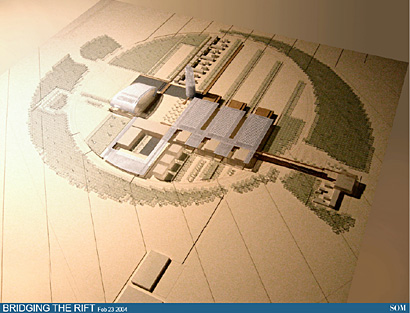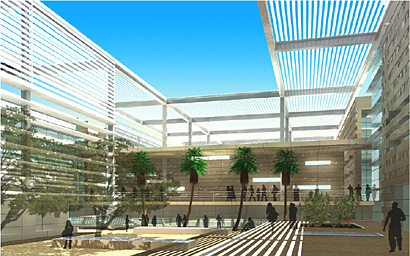

|
| Stanford Report, Mar. 3, 2004 | ||
|
Environmental research center planned for Israel-Jordan border BY MARK SHWARTZ In an effort to encourage scientific collaboration between Arab and Israeli students, the governments of Jordan and Israel have agreed to set aside 150 acres along their border for the construction of a major environmental research center that will be operated in collaboration with Stanford University and Cornell University.   A groundbreaking ceremony will take place March 9 for the Bridging the Rift Center -- an environmental research facility that will be located along the Israeli-Jordanian border south of the Dead Sea. The new life sciences center will be operated in collaboration with Stanford, Cornell and universities in Israel and Jordan. Credit: Mustafa Abadan and T.J. Gottesdiener, Skidmore, Owings & Merrill LLP Groundbreaking for the new Bridging the Rift Center will take place March 9 in a remote section of arid land along the Israeli-Jordanian border about 50 miles south of the Dead Sea. When construction is completed in three to five years, this small piece of desert will be transformed into a thriving science and technology village dedicated to studying the unique ecology of the Dead Sea region. The high-tech center will symbolically straddle the border so that half of the facility is in Israel and half is in Jordan. Government officials, academicians and business leaders from both countries are expected to attend the groundbreaking ceremony, along with representatives from Stanford and Cornell -- the two universities that will oversee academic research at the center. "Stanford is a place where faculty and students from many countries and backgrounds come together to research, discuss and propose solutions to significant contemporary problems," said Stanford President John L. Hennessy. "This center reflects the best of those values, and we have every hope that it will succeed in its important mission." The Stanford magnet Seed money for the new research center was provided by the Bridging the Rift Foundation, a New York-based nonprofit organization that includes business executives, academicians and community leaders from Jordan, Israel and the United States. "The BTR Foundation was the visionary behind the initiative," said businessman Mati Kochavi, chief executive officer of the foundation. "We mobilized the governments to give the land, solved the security issues and worked with universities on the research and academic program." A native of Israel now living in New York, Kochavi speaks Hebrew and Arabic and frequently travels to Arab countries to see business associates and friends. It was Kochavi who came up with the idea of enlisting Stanford as a partner in the project. "I called Cornell first because we thought the focus would be on agriculture, and Cornell has an excellent school of agriculture," he recalled. "But the people we talked to in Jordan wanted to move toward plant biotechnology and biotechnology in general." Kochavi immediately thought of Stanford because of its reputation in combining science, technology and business. "We needed a magnet to bring people together, and the opportunity of getting a Ph.D. from Stanford creates a magnet. People in the Middle East were more than excited when they heard about Stanford's willingness to be involved." Extreme environment Eventually, both universities were brought in as academic partners, said Stanford geneticist Marcus W. Feldman, the Burnet C. and Mildred Finley Wohlford Professor in the School of Humanities and Sciences. For the past three years, Feldman has chaired the academic planning committee of the foundation and made several trips to the Middle East to meet with officials and observe the proposed site. "The center is located is an extremely interesting environment," he said. "There are numerous organisms in the Dead Sea, the most saline body of water on Earth, and in the desert, one of the hottest places on the planet. How they are able to survive in such extreme conditions is of great interest to geneticists and other life scientists." The faculty at the center will consist of scientists from Stanford, Cornell and various Jordanian and Israeli universities. Feldman predicts that the number of students, staff, faculty and postdoctoral fellows at the center could reach 1,000. "We expect people to come from all over the Middle East," he said. "There's really no limit if people of good will want to participate." An important component of the center, added Kochavi, will be the Library of Life -- a project that will allow Stanford and Cornell scientists to create a databank of all living organisms in the Dead Sea region. "This center is the first of its kind in the Middle East -- a hub for technology, research and education for all people in Middle Eastern countries and initially Jordan and Israel," he said. "It is vital that we look past the disputes of the moment and have the courage and vision to work for a better future." Visionary project Doctoral students from Jordan and Israel will begin applying to either Stanford or Cornell later this year. Those admitted will come to the United States for about two years, then return to the center to conduct laboratory and field research in desert ecology, explained Arthur Bienenstock, vice provost and dean of research at Stanford. "I see the center as visionary, but I see Stanford as a place that has thrived on visionary endeavors," he said. "I hope it's successful, because cooperation in that region is vital." Bienenstock, Feldman and several other members of the Stanford faculty plan to attend next week's groundbreaking, which will begin with a breakfast at the home of Israeli Prime Minister Ariel Sharon. Later that evening, King Abdullah II of Jordan will host an event at the Royal Court in Amman. According to Kochavi, both leaders strongly support the center, which was only approved after years of complex negotiations among ministries from both countries. "Nothing has been simple about this project, but this kind of effort is necessary if you want to a make a shift in the Middle East paradigm," Kochavi said. "The new center can serve science and peace simultaneously," Feldman noted. "The development of a critical mass of professionals and researchers in science is also essential for more equitable economic advancement of the region. As Israelis and Jordanians study and work together with scholars from around the world, the benefits of peace will become too obvious to ignore."
|
|
|